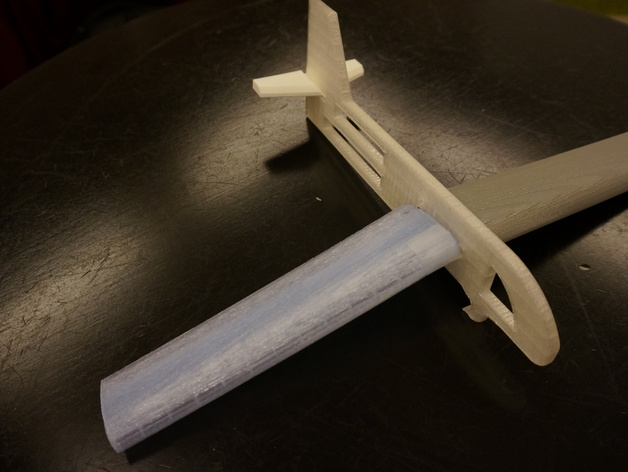
Airplane Wing Variations
thingiverse
Project: Airplane Wing Design for Optimal Performance Print Settings Printer Brand: MakerBot Printer: MakerBot Replicator (5th Generation) Rafts: Yes Supports: No Resolution: standard Infill: 5% Notes: We started with the standard printer settings. We reduced the infill to 5% to make the parts lighter and to have them print faster. The reduced infill did not seem to affect the integrity of the parts. How I Designed This This was a team project done at a Makeathon workshop. The plane parts have not been tested for flight, and may need to be modified. None of the parts were designed mathematically for maximum flight performance, and it is recommended that the instructor work this out before presenting to students. We printed the tail separate from the body, and on our first try, it did not fit together. Care should be given to the tolerances of joined parts that have no flexibility. It was suggested that we only print out the connecting parts to save time just to perfect the joint. Our wings and our airfoils were designed to use straws or dowels for construction. User preferences may vary. It was our intention to just give an alternative to the foam tray airplanes originally in the lesson plan. More advanced students could be more precise with their designs than the traditional foam would allow. All parts for the airplane were designed in AutoDesk Inventor. Overview and Background In this project, students will study airplane wing design (airfoil shape, size, and wing angle) to determine which design works best for keeping the plane aloft. There are three levels to this project: beginner, intermediate and advanced. -Beginners will use parts provided by the educator and just test the various wing designs and angles. -Intermediate students will use various airfoils wrapped with different material to find the which airfoil shape performs best -Advanced students will use design software to come up with a wing design that should meet the criteria for performance. Lesson Plan and Activity This lesson is a variation of the Navy's STEM in the Classroom Lesson Plan found here: http://www.navystemfortheclassroom.com/sites/navystemfortheclassroom.com/files/lesson-plans/documents/JetsInFlightLessonPlan_Final_0.pdf A copy of this lesson can be found in thing files There is a PowerPoint Presentation to use with your class that is also in thing files. The only change in this lesson is the materials list provided to the students on page 24 of the attached PowerPoint presentation. Objectives Students will be learning the physics of flight. Depending on the level, students will use design software to create their own wing design to meet performance criteria. Audience Grades 9-12 Subjects Science (physics), and Math Skills Learned National Science Education Standards Science as Inquiry Students will • Identify questions and concepts that guide scientific investigations • Design and conduct scientific investigations • Use technology and mathematics to improve investigations and communications • Formulate and revise scientific explanations and models using logic and evidence • Communicate and defend a scientific argument Physical Science • Use mathematics and logic to explain scientific principles Science and Technology • Identify a problem or design an opportunity • Propose designs and choose between alternative solutions • Implement a proposed solution • Evaluate a solution and its consequences • Communicate the problem, process, and solution
With this file you will be able to print Airplane Wing Variations with your 3D printer. Click on the button and save the file on your computer to work, edit or customize your design. You can also find more 3D designs for printers on Airplane Wing Variations.
